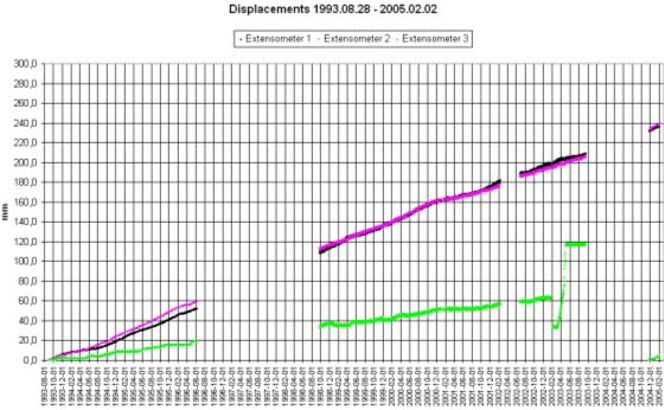Monitoring and deformation processes
Monitoring and deformation process (3D kinematics) and Microseismic monitoring.
Monitoring and deformation process (3D kinematics)
An understanding of the 3D kinematics (movement pattern) is of major importance for evaluating hazards and for numerical modeling. A Ph.D. student (Guro Grøneng) will focus on creep and deformation processes, including 3D modeling.
The project will use existing monitoring data, e.g., from the Åknes site in Møre & Romsdal, where automatic extensometers have been operating for more than 10 years. Several new monitoring systems will be installed at this site during the next 2 years, and these data will be an essential part of these studies.

The extensometers at the Åknes failure measure movement.
Microseismic monitoring
Another monitoring method explored at the Åknes failure was passive microseismic monitoring. Microseismic events expected to be seen in unstable rock slope sites are events directly related to the mass movement (e.g., shear failures at the detachment plane, the opening of fractures, etc.) and second-order events associated with rock falls, small-scale slides, etc.

The spatial and temporal distribution of microseismic events can provide valuable information on the internal structure and the dynamic behavior of the slope. In a pilot study, a temporary small-scale seismic network consisting of 6 geophones was installed during the summer/fall of 2004. The primary purpose of the pilot installation was to check if we could see any seismic activity at all and to get an idea of the noise conditions.
Even with relatively insensitive geophones, we observed more than 350 microseismic events during the monitoring period of 71 days. We considered signals as microseismic events if they had a short duration (less than 5 sec) and could be observed on at least 4 geophones with a signal-to-noise ratio better than 2.
Excluding positively identified man-made events, we end up with a rate of about 3.5 microseismic events per day. The network was too small, and the signal quality too poor to localize the seismic events accurately, but we could determine the direction of some of the strongest incoming signals. They are generated within the unstable part of the slope, downhill from the geophone network.
We plan to install a temporary network in 2005 with a larger aperture and more receivers. In the framework of the investigations of the Åknes site, boreholes will be drilled for direct sampling and instrumentation with different sensors. Depending on the progress of the drilling, we might be able to install borehole seismometers at the end of the field campaign 2005 and set up a permanent network.